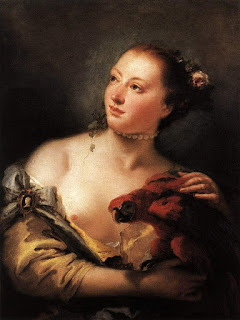
a letter from the journal MNEMOSYNE, Volume 53, Issue 6 ...
OVID’S DEAD PARROT SKETCH: Amores II.6
In an article published in the Classical Journal for 1987, (1) B.W. Boyd cogently argued for an identification of certain characteristics displayed by Corinna’s parrot, famously commemorated in Ovid’s Amores II.6, with elements of the conventional self-depiction of the Roman elegiac lover.
There are none the less a number of parallels between parrot and love poet which Boyd in her study either omits or considers insignificant. The observations in this brief note are therefore intended to supplement the references adduced by Boyd to illustrate her contention that “to the last, this bird behaves like the lover-poet of elegy”, (2) and to support her interpretation of the poem as an allegorical treatment of Ovid’s literary predecessors.
Boyd is particularly concerned to emphasise the ‘Alexandrian’ qualities which the parrot represents. (3) The description of the parrot’s grave (ossa tegit tumulus—tumulus pro corpore magnus—| quo lapis exiguus par sibi carmen habet, ( 59-60) is only ‘Alexandrian’, however, to the extent that Roman elegists professed and adopted Alexandrian aesthetic principles; (4) what is of greater significance is that the bird’s resting-place is Propertian (5) (cf. Prop. II.1.72, breve in exiguo marmore nomen ero; II.13.33, sit in exiguo laurus super addita busto).
Likewise, although the Underworld reserved for piae volucres (49-58) contains elements which recall details of the Virgilian sedes beatae in Aeneid VI.367 V., it also includes features of the erotic Elysium of Tibullus I.3.57 V. (Boyd 205).
The principal relevance of these allusions is to establish the parrot’s poetic analogue as primarily a Roman love elegist. Further resemblances are noted by Boyd (and Cahoon [n. 5], (34): the parrot/poet is vox mutandis ingeniosa sonis (18); he produces tam bene verba (24); he is characteristically garrulus (26) and possessed of sermonis amore (29). Finally, he is described as loquax humanae vocis imago (37), and calls upon the mistress whom he served with his dying breath (48; cf. Tib. I.1.59-60; Prop. I.10.5-6).
Boyd’s article (202) identifies the elegiac connotations in the parrot’s epitaph (61-2) of placuisse and dominae, but it should be added that the theme of love enduring beyond the grave is itself a standard tñpow of Roman amatory elegy, 6) and is especially characteristic of Propertius’ sensibility—
cf. Prop. I.19.12, traicit et fati litora magnus amor, II.14.10, 15.39-40, IV.7.93-4 inter alia. Propertius’ epitaph on himself, ardoris nostri magne poeta iaces (I.7.24) also finds a parallel at line 20 of Ovid’s poem, infelix avium gloria nempe iaces, which, in addition to sharing the final word of the
Propertian line, resembles closely its metrical scheme.
The values observed by the parrot and its avian company are phrased in familiar terms: piae volucres (3, 51, 58), omni concordia (13), fides (14, 17; cf. Baker, n. (6), concepts appropriate to the domain of Roman elegiac poets since the time of Catullus. (7) Furthermore, as a placidae pacis amator
(26), the parrot subscribes to the non-militaristic ethos of previous elegists, recalling in particular Propertius’ emphatic assertion (III.5.1):8) pacis Amor deus est, pacem veneramur amantes.
Commentators have not failed to observe the implications of Ovid’s presentation of doves, both in the parrot’s relationship (albeit a non-erotic one) with the turtur, and more specifically with the doves of the ornithological paradise of 49-58. On oscula dat cupido blanda columba mari (56), Schmidt (n. 5, 219) remarks, “Blandus ist ein Kennwort der Elegie”, while Propertius, speaking as the elegist inspired, addresses doves, traditionally associated with Venus, the goddess of love, (9) as Veneris dominae volucres, mea turba, columbae (III.3.31). (10) The symbolism attached to this particular species of bird thus reinforces the impression that Ovid’s depiction of the nemoralis sedes (57) granted to his mistress’ pet after death has a more than literal significance in the context of this poem.
By means of these references, Ovid makes Corinna’s treasured parrot embody a variety of the most clichéed characteristics and hackneyed motifs of his predecessors in the elegiac genre. (11) The similarities between this elegy and the lament for Tibullus, Amores III.9, may not, on this view, be
determined simply by the employment of conventional motifs, (12) although it is hard to believe that the poet intends to display malice towards his fellow-elegist in that moving piece. The effect is, of course, primarily humorous, but is it too fanciful to ask whether it could be the case that, in his
identification of demised parrot with stereotyped elegiac lover-poet, (13) Ovid allusively signals the death of traditional, ‘sincere’ (14) amatory elegy at Rome?
Such a reading is not only plausible in itself; it is also perfectly consonant with Ovid’s manipulation of the themes of his elegiac predecessors elsewhere in the Amores. (15)
Oxford, Merton College L.B.T. Houghton







